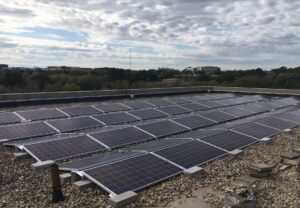Sustainable Trends for Viable Office Space in 2022 and Beyond
COVID-19 dramatically impacted traditional space office in America and accelerated a trend that has been in motion for several decades – a push to become more sustainable in the workspace. Sustainability has become critical to companies who are feeling the pressure to contribute to climate goals, control office costs and incorporate sustainability into their recruitment strategies.
Throughout the commercial real estate industry, sustainable new construction and sustainable retrofits of older buildings are becoming more common. Many companies have Environmental, Social, and Governance (ESG) goals to meet, even as younger works are demanding environmentally friendly, safe, and healthy workspaces.
Compass Properties has long embraced sustainability as a core value. “Sustainability is a strong part of our culture,” said Compass Properties Executive Vice President Todd Greenwald, who spearheads the company’s sustainable facilities management practices. “For all our properties, we set out with three goals in mind: reduce waste, encourage healthy lifestyles, and implement energy-saving programs.” Greenwald said Compass Properties is a proud supporter of Sustain Dane, which he calls an “an amazing resource for businesses in the county for all aspects of sustainable actions and outcomes.”
There is little question that sustainable building and facilities practices are critical in today’s business environment. To stay relevant in an increasingly remote and environmentally conscious society, modern office spaces need to engage in sustainable practices that lower day-to-day nonrenewable energy consumption, while reducing future energy demands as well.

Solar panels recently added to our Park West II building are producing 27,600 kWh of power estimated annual energy savings of $4,600.
Making the office “greener” is one trend that is catching on in buildings throughout America. Many companies today are providing accessible green spaces (small gardens, pet friendly zones, etc.) featuring all manners of plants. Scientific research has shown the color green helps create an environment of peace, relaxing the mind, reducing stress and helps staff to maintain concentration for longer.
Another trend that impacts sustainability and productivity is “daylighting,” –maximizing the amount of natural light. Numerous studies have shown that natural light in office spaces improves worker satisfaction and productivity. Since natural light reduces the need for artificial lighting during daytime hours, it can also lower energy costs and send a positive message to environmentally conscious workers. More buildings today are replacing traditional walls with glass walls and using full-spanning windows on the building’s south-facing side to maximize sunlight throughout the day.
There are several ways that companies and their employees can contribute to sustainability goals daily. It’s not just good for your business, it’s a great way of demonstrating your commitment to the environment. These include:
- Look to replace disposable utensils and products with reusable products as much as possible
- Use Green Cleaning Products that not only protect the health of your cleaning staff, but also your employees, by eliminating harmful substances and odors.
- Eliminate paper waste, by reduces printing, digitalizing as much as you can, and use environmentally friendly paper.
In terms of new construction and retrofits of existing office buildings, the hottest new thing in sustainable building is wood. The hype is focused on “mass timber,” a term that includes glue-laminated beams, laminated veneer lumber, nail-laminated timber (NLT), and cross-laminated timber (CLT).
